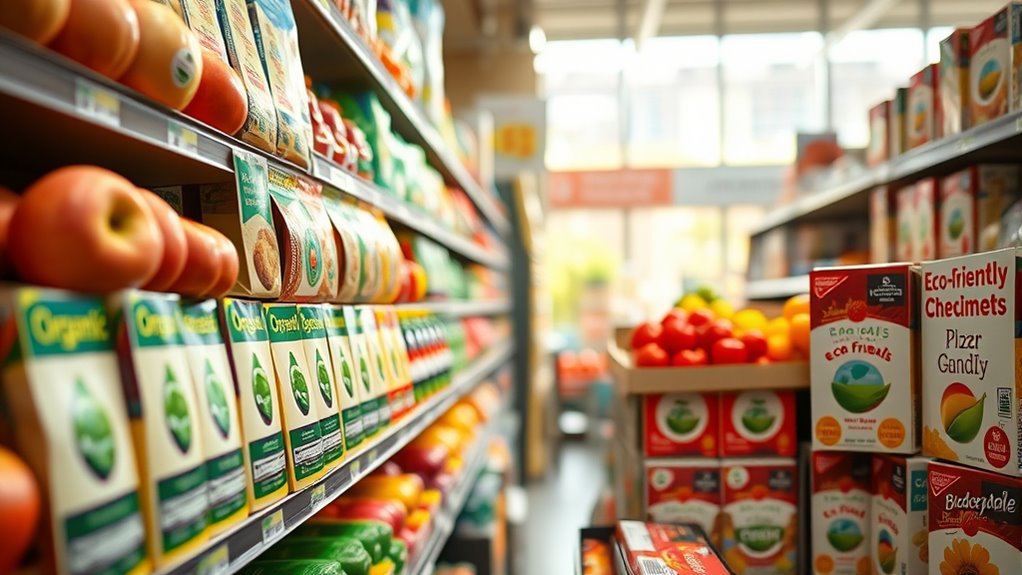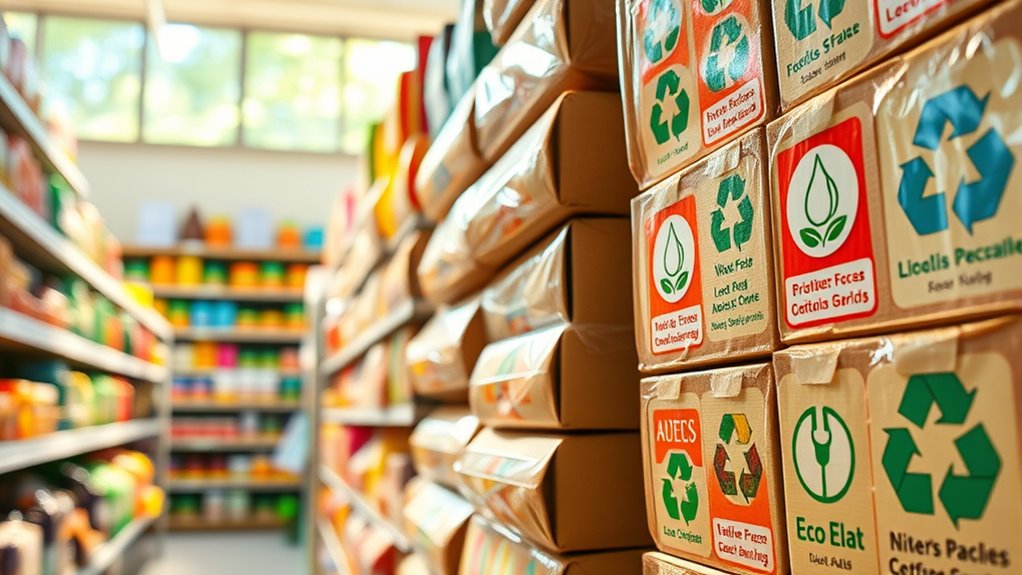In 2025, decoding eco-labels on your groceries helps you make informed, sustainable choices. Focus on certifications from trusted third parties that verify claims about environmental practices and fair trade. Look for logos indicating organic farming, resource conservation, or social equity to guarantee authenticity. Beware of labels that use vague eco-friendly language without proof. Mastering these clues allows you to support brands that genuinely prioritize sustainability—if you want to uncover more, the details ahead will guide you further.
Key Takeaways
- Recognize and differentiate between eco-labels based on their themes, such as sustainable farming and fair trade certification.
- Look for reputable certification logos and third-party verification to confirm eco-label authenticity.
- Understand that fair trade labels ensure ethical wages and social equity for producers.
- Be cautious of companies using eco-friendly language without credible proof or recognized certifications.
- Decoding labels empowers informed purchasing and encourages brands to maintain high social and environmental standards.

As consumers become increasingly eco-conscious, the battle over eco-labels has intensified, revealing conflicting claims and standards. When you head to the grocery store in 2025, you’ll notice a dizzying array of labels on products, all claiming to be better for the environment or more ethically produced. But what do these labels really mean? Understanding eco-labels can feel overwhelming, especially when some focus on sustainable farming, while others highlight fair trade certification. Recognizing the differences helps you make more informed choices and supports brands that genuinely align with your values.
As eco-labels multiply, understanding their true meaning helps you make more ethical, sustainable choices at the store.
Sustainable farming is a common theme across many eco-labels. It indicates that the product was grown using environmentally friendly practices that conserve resources, promote soil health, and reduce chemical usage. These labels often assure you that the farmers avoided synthetic pesticides and fertilizers, prioritized crop diversity, and minimized water waste. But not all labels are equally strict or transparent. Some might rely on vague claims, while others are backed by rigorous standards. When you see a label emphasizing sustainable farming, check for certifications or third-party verifications to ensure authenticity. This way, you’re supporting agricultural practices that protect ecosystems and promote long-term food security.
Additionally, certification standards play a crucial role in establishing the credibility of eco-labels, helping consumers differentiate between genuine and misleading claims. Fair trade certification is another critical eco-label you’ll encounter. It highlights that the product’s producers received fair wages and worked under safe conditions, fostering social equity alongside environmental sustainability. Fair trade also encourages community development and empowers marginalized farmers and workers. If you see this label on coffee, chocolate, or spices, it signals that your purchase supports more equitable trade practices, helping lift communities out of poverty. While fair trade certification primarily focuses on social justice, it often overlaps with sustainability efforts, ensuring that production methods don’t harm the environment or exploit labor. Choosing products with fair trade labels aligns your shopping with ethical and eco-friendly principles, making a tangible difference in the lives of producers and their communities.
However, the proliferation of labels can sometimes be confusing or even misleading. Some companies may use eco-friendly language without concrete proof, or combine multiple claims to appeal to your conscience. That’s why it’s essential to look beyond the label and do a little research. Check for recognized certification logos and understand what each one guarantees. When you take the time to decode these labels, you’re not just making more conscious purchases—you’re actively supporting sustainable farming practices and fair trade initiatives that aim to create a healthier planet and more equitable global economy. This knowledge empowers you to vote with your wallet and encourage brands to uphold high standards of sustainability and social responsibility.
Frequently Asked Questions
How Do Eco-Label Standards Vary Between Countries?
You’ll notice that eco-label standards vary between countries due to international differences in regulations and environmental priorities. Certification processes differ too, with some nations requiring rigorous third-party verification, while others rely on self-assessment. These variations mean that a product labeled eco-friendly in one country might not meet the criteria elsewhere. Staying aware of these differences helps you make truly sustainable choices when shopping internationally.
Are Eco-Labels Always Reliable Indicators of Sustainability?
Question quickly quivers with questions: are eco-labels always honest? You should be cautious, as greenwashing deception can disguise true sustainability, making labels misleading. The complexity of labels adds to confusion, so don’t take them at face value. Instead, dig deeper, research standards, and look for trusted certifications. Remember, not all eco-labels are equal; some may overstate their eco-credentials, so stay sharp and scrutinize every symbol.
Can Eco-Labels Influence the Price of Groceries?
Eco-labels can influence the price of your groceries by creating a price premium, as products with these labels often cost more due to sustainable practices. Your consumer awareness of eco-label significance encourages brands to meet higher standards, which can drive prices up. When you recognize the value of eco-labels, you’re more likely to pay extra for environmentally friendly options, boosting overall market demand for sustainable products.
What Are the Most Common Misconceptions About Eco-Labels?
You might think eco-labels are a magic bullet, but don’t buy into the sustainable myths. Many believe they guarantee perfect sustainability, yet labeling confusion remains. The most common misconception is that all eco-labels are equally strict, which isn’t true. In reality, some labels focus on specific aspects, so you need to look closely. Don’t assume every sticker equals eco-friendliness—do your homework to make informed choices.
How Can Consumers Verify the Authenticity of Eco-Labels?
To verify eco-labels, you should check for transparency in their supply chain and review the certification process. Look for labels from reputable organizations that clearly outline their standards and verification methods. You can also visit the certifier’s website to confirm the product’s certification status. Trustworthy eco-labels have rigorous procedures, so doing a bit of research guarantees you’re making authentic, eco-friendly choices, not just greenwashing.
Conclusion
As you scan your grocery labels, remember they’re like a map guiding you through a forest of claims. By decoding eco-labels, you’re not just choosing products—you’re steering your choices toward sustainability. Every label is a signpost pointing to better practices and greener options. So, stay curious and vigilant, turning your shopping into a powerful act of environmental support. Like a lighthouse guiding ships, let these labels illuminate your path to a more eco-friendly future.









